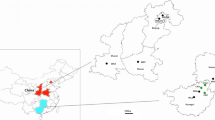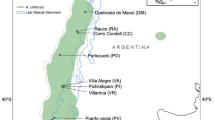Abstract
The genetic resources of a particular species of flowering cherry, Cerasus jamasakura, have high conservation priority because of its cultural, ecological and economic value in Japan. Therefore, the genetic structures of 12 natural populations of C. jamasakura were assessed using ten nuclear SSR loci. The population differentiation was relatively low (F ST, 0.043), reflecting long-distance dispersal of seeds by animals and historical human activities. However, a neighbor-joining tree derived from the acquired data, spatial analysis of molecular variance and STRUCTURE analysis revealed that the populations could be divided into two groups: one located on Kyusyu Island and one on Honshu Island. Genetic diversity parameters such as allelic richness and gene diversity were significantly lower in the Kyushu group than the Honshu group. Furthermore, STRUCTURE analysis revealed that the two lineages were admixed in the western part of Honshu Island. Thus, although the phylogeographical structure of the species and hybridization dynamics among related species need to be evaluated in detail using several marker systems, the Kyusyu Island and Honshu Island populations should be considered as different conservation units, and the islands should be regarded as distinct seed transfer zones for C. jamasakura, especially when rapid assessments are required.




Similar content being viewed by others
References
Coart E, Glabeke SV, Petit RJ, Bockstaele EV, Roldán-Ruiz I (2005) Range wide versus local patterns of genetic diversity in hornbeam (Carpinus betulus L.). Conserv Genet 6:259–273
Cornuet JM, Luikart G (1996) Description and power analysis of two tests for detecting recent population bottlenecks from allele frequency data. Genetics 144:2001–2014
Crandall KA, Bininda-Emonds ORP, Mace GM, Wayne RK (2000) Considering evolutionary processes in conservation biology. Trends Ecol Evol 15:290–295
Dirlewanger E, Cosson P, Tavaud M, Aranzana M, Poizat C, Zanetto A, Arús P, Laigret F (2002) Development of microsatellite markers in peach (Prunus persica (L.) Batsch) and their use in genetic diversity analysis in peach and sweet cherry (Prunus avium L.). Theor Appl Genet 105:127–138
Dupanloup I, Schneider S, Excoffier L (2002) A simulated annealing approach of define the genetic structure of populations. Mol Ecol 11:2571–2581
El Mousadik A, Petit RJ (1996) High level of genetic differentiation for allelic richness among populations of the argan tree (Argania spinosa (L.) Skeels) endemic to Morocco. Theor Appl Genet 92:832–839
Evanno G, Regnaut S, Goudet J (2005) Detecting the number of clusters of individuals using the software STRUCTURE: a simulation study. Mol Ecol 14:2611–2620
Excoffier L, Smouse PE, Quattro JM (1992) Analysis of molecular variance inferred from metric distance among DNA haplotypes: application to human mitochondrial DNA restriction data. Genetics 131:479–491
Falush D, Stephens M, Pritchard JK (2003) Inference of population structure using multilocus genotype data: linked loci and correlated allele frequencies. Genetics 164:1567–1687
Fineschi S, Taurchini D, Villani F, Vendramin GG (2000) Chloroplast DNA polymorphism reveals little geographical structure in Castanea sativa Mill. (Fagaceae) throughout southern European countries. Mol Ecol 9:1495–1503
Frankel OH (1974) Genetic conservation: our evolutionary responsibility. Genetics 78:53–65
Frascaria N, Santi F, Gouyon PH (1993) Genetic differentiation within and among populations of chestnut (Castanea sativa Mill.) and wild cherry (Prunus avium L.). Heredity 70:634–641
Godoy JA, Jordano P (2001) Seed dispersal by animals: exact identification of source trees with endocarp DNA microsatellites. Mol Ecol 10:2275–2283
Goudet J (2001) FSTAT; a program to estimate and test gene diversities and fixation indices version 2.9.3. http://www.unil.ch/izea/softwares/fstat.html
Goudet J, Raymond M, de Meeus T, Rousset F (1996) Testing differentiation in diploid populations. Genetics 144:1933–1940
Hewitt GM (1999) Post-glacial re-colonization of European biota. Biol J Linn Soc 68:87–112
Hufford KM, Mazer SJ (2003) Plant ecotypes: genetic differentiation in the age of ecological restoration. Trend Ecol Evol 18:147–155
Kato S, Mukai Y (2004) Allelic diversity of S-RNase at the selfincompatibility locus in natural flowering cherry populations (Prunus lannesiana var. speciosa). Heredity 92:249–256
Katsuki T (2001) Flowering cherries in Japan (in Japanese). Gakken, Tokyo
Kuitert W (1999) Japanese flowering cherries. Timber, Portland
Langella O (2007) Populations 1.2.30: population genetic software (individuals or populations distances, phylogenetic trees). France. http://bioinformatics.org/~tryphon/populations/
Lefèvre F (2004) Human impacts on forest genetic resources in the temperate zone: an updated review. For Ecol Manage 197:257–271
Magri D, Vendramin GG, Comps B, Dupanloup I, Geburek T, Gömöry D, Latałowa M, Litt T, Paule L, Roure JM, Tantau I, van der Knaap WO, Petit RJ, de Beaulieu JL (2006) A new scenario for the Quaternary history of European beech populations: palaeobotanical evidence and genetic consequences. New Phytol 171:199–221
Magri D, Fineschi S, Bellarosa R, Buonamici A, Sebastiani F, Schirone B, Simeone MC, Vendramin GG (2007) The distribution of Quercus suber chloroplast haplotypes matches the palaeogeographical history of the western Mediterranean. Mol Ecol 16:5259–5266
Marriette S, Lefranc M, Legrand P, Taneyhill D, Frascaria-Lacoste N, Machon N (1997) Genetic variability in wild cherry populations in France. Effects of colonizing processes. Theor Appl Genet 94:904–908
McKay JK, Christian CE, Harrison S, Rice KJ (2005) How local is local?––a review of practical and conceptual issues in the genetics of restoration. Restor Ecol 13:432–440
Mohanty A, Martín JP, Aguinagalde I (2001) A population genetic analysis of chloroplast DNA in wild populations of Prunus avium L. in Europe. Heredity 87:421–427
Moritz C (1994) Defining ‘evolutionary significant units’ for conservation. Trend Ecol Evol 9:373–375
Moritz C (2002) Strategies to protect biological diversity and the evolutionary process that sustain it. Syst Biol 51:238–254
Nei M (1987) Molecular evolutionary genetics. Columbia University Press, New York
Nei M, Tajima F, Tateno Y (1983) Accuracy of estimated phylogenic trees from molecular data. J Mol Evol 19:153–170
Ogawa K (1993) Flowering cherries (in Japanese). Shincho-Shoseki, Tokyo
Ohba H (1992) Japanese cherry trees under the genus Cerasus (Rosaceae). J Jpn Bot 67:276–281
Ohba H (2001) Flora of Japan. In: Iwatsuki K, Boufford DE, Ohba H (eds) Angiospermae, Dicotyledoneae, Archichlamydeae (b), vol IIb. Koudansha, Tokyo
Ohta S, Yamamoto T, Nishitani C, Katsuki T, Iketani H, Omura M (2007) Phylogenetic relationships among Japanese flowering cherries (Prunus subgenus Cerasus) based on nucleotide sequences of chloroplast DNA. Plant Syst Evol 263:209–225
Peakall R, Smouse PE (2005) GENALEX 6: genetic analysis in Excel. Population genetic software for teaching and research. Mol Ecol Notes 6:288–295
Pearse DE, Crandall KA (2004) Beyond F ST: analysis of population genetic data for conservation. Conserv Genet 5:585–602
Piry S, Luikart G, Cornuet JM (1999) BOTTLENECK: a computer program for detecting recent reductions in the effective population size using allele frequency data. J Hered 90:502–503
Pritchard JK, Stephens M, Donnelly P (2000) Inference of population structure using multilocus genotype data. Genetics 155:945–959
Pritchard JK, Wen W, Falush D (2007) STRUCTURE ver.2.2. University of Chicago, Chicago. http://pritch.bsd.uchicago.edu/
Rice WR (1989) Analyzing tables of statistical tests. Evolution 43:223–225
Rousset F (1997) Genetic differentiation and estimation of gene flow from F-statistics under isolation by distance. Genetics 145:1219–1228
Soons MB, Ozinga WA (2005) How important is long-distance seed dispersal for the regional survival of plant species? Divers Distrib 11:165–172
Suzuki M (2002) Japanese and culture of trees (in Japanese). Yasaka-Shobo, Tokyo
Taberlet P, Fumagalli L, Wust-Saucy AG, Cosson J-F (1998) Comparative phylogeography and postglacial colonization route in Europe. Mol Ecol 7:453–464
Takeuchi K, Brown RD, Washitani I, Tsunekawa A, Yokohari M (2003) Satoyama: the traditional rural landscape of Japan. Springer, Tokyo
Takeuchi M, Tamura M, Iijima K (2005) Organisms on cherry trees (in Japanese). Tokyo University of Agriculture Press, Tokyo
Testolin R, Marrazo T, Cipriani G, Quarta R, Verde I, Dettori MT, Pancaldi M, Sansavini S (2000) Microsatellite DNA in peach(Prunus persica L. Batsch) and its use in fingerprinting and testing the genetic origin of cultivars. Genome 43:512–520
Tomaru N, Mitsutsuji T, Takahashi M, Tsumura Y, Uchida K, Ohba K (1997) Genetic diversity in Fagus crenata (Japanese beech): influence of the distributional shift during the Late-Quaternary. Heredity 78:241–251
Tsuda Y, Ide Y (2005) Wide-range analysis of genetic structure of Betula maximowicziana, a long-lived pioneer tree species and noble hardwood in the cool temperate zone of Japan. Mol Ecol 14:3929–3941
Tsuda Y, Goto S, Ide Y (2004) RAPD analysis of genetic variation within and among four natural populations of Betula maximowicziana. Silvae Genet 53:234–239
Wagner DB, Furnier GR, Saghai MA, Williams SM, Dancik BP, Allard RW (1987) Chloroplast DNA polymorphism in lodgepole and jack pines and their hybrids. Proc Natl Acad Sci USA 84:2097–2100
Weir BS, Cockerham CC (1984) Estimating f-statistics for the analysis of population structure. Evolution 38:1358–1370
Whittaker RJ, Araújo MB, Jepson P, Ladle RJ, Watson JE, Willis KJ (2005) Conservation biogeography: assessment and prospect. Divers Distrib 11:3–23
Wright S (1943) Isolation by distance. Genetics 28:114–138
Acknowledgments
We are grateful to Chikako Fuchimoto, Reiko Mizusawa, Saneyoshi Ueno, So Hanaoka, Yasuomi Ohta and Yasuko Hakamada for their help in sampling the plant material. This research was supported by a grant for “Research on Genetic Guidelines for Restoration Programs using Genetic Diversity Information” from the Ministry of Environment, Japan.
Author information
Authors and Affiliations
Corresponding author
Rights and permissions
About this article
Cite this article
Tsuda, Y., Kimura, M., Kato, S. et al. Genetic structure of Cerasus jamasakura, a Japanese flowering cherry, revealed by nuclear SSRs: implications for conservation. J Plant Res 122, 367–375 (2009). https://doi.org/10.1007/s10265-009-0224-x
Received:
Accepted:
Published:
Issue Date:
DOI: https://doi.org/10.1007/s10265-009-0224-x




